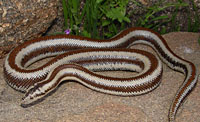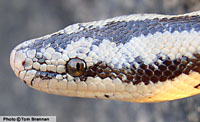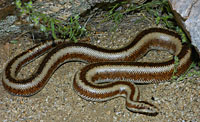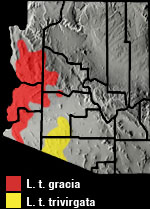Online Field Guide to The Reptiles and Amphibians of Arizona


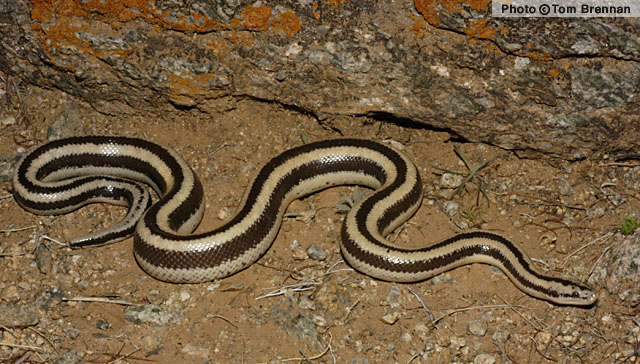
Lichanura trivirgata trivirgata. Maricopa County, AZ
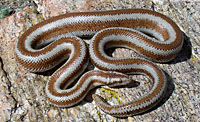 L. t. gracia La Paz Co., AZ |
||
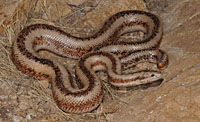 L. t. gracia Maricopa Co., AZ |
| ROSY BOA Lichanura trivirgata |
Non-Venomous
|
| DESCRIPTION: A medium-sized (up to 950 mm or 37″ in total length), heavy bodied snake with three wide, dark brown, black, orange, or reddish-brown stripes on a light cream, tan, or gray background. The head is only slightly larger than the neck and the tail is relatively blunt. The eyes are small and the pupils are vertically elliptical. The scales are smooth. The scales on the top of the head are small and rounded, unlike the large, flat head plates of most non-venomous snakes in Arizona. On males vestigial hind limbs are present in the form of two small spurs, one protruding from each side of the vent.
DISTRIBUTION: This snake is found in western, southwestern, and south central Arizona at elevations ranging from near sea level to just over 5,600′. It has not yet been documented from the many mountain ranges, with seemingly suitable habitat, between the known ranges of Arizona’s two subspecies. HABITAT: In Arizona the Rosy Boa inhabits Sonoran Desertscrub, Mohave Desertscrub, and Interior Chaparral communities. In some areas it enters the lower reaches of Great Basin Conifer Woodland. It is usually associated with rocky or boulder-strewn habitat on mountains, bajadas or hillsides. This amazing snake inhabits some of southwestern Arizona’s hottest, driest, and most inhospitable mountain ranges. DIET: This powerful constrictor feeds on a variety of small mammals and birds. REPRODUCTION: Mating takes place in spring. Three to 14 young are born in late summer or early fall. REMARKS: The Rosy Boa is a member of Boidae, a family that includes the giant anacondas and large boa constrictors of South America. By Thomas C. Brennan Brennan, T. C., and A. T. Holycross. 2006. A Field Guide to Amphibians and Reptiles in Arizona. Arizona Game and Fish Department. Phoenix, AZ Brennan, T. C., and A. T. Holycross. 2005. A Field Guide to Amphibians and Reptiles of Maricopa County. Arizona Game and Fish Department. Phoenix, AZ Brennan, Thomas C. and M. J. Feldner. 2001 Lichanura trivirgata trivirgata. Geographic Distribution. Herpetological Review 32(3). Stebbins. 1985. Western Reptiles and Amphibians. Houghton Mifflin. New York, NY |
|
Visit Partners in Amphibian and Reptile Conservation:


HOME
Copyright © 2023, Arizona Game and Fish Department. All rights reserved.
If you make use of the textual contents of this site in reports, publications, etc. please cite and credit the author(s) and photographer(s). All photos on this website are copyrighted. However, those found in the species account section may be used for any noncommercial scientific, educational, or conservation purposes provided that photographs are not altered and continue to bear the copyright symbol and name of the photographer. Please contact the photographer regarding commercial use of copyrighted photographs.










